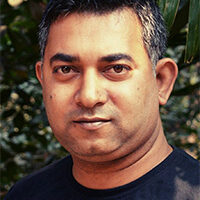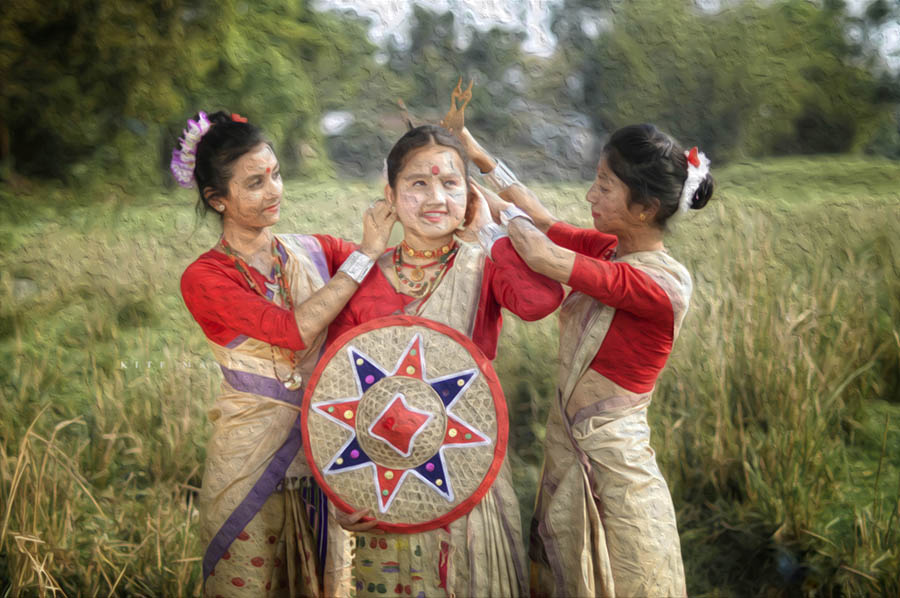About Niladri

Niladri Chakraborty writes fiction and poetry. His writings have been published in The Assam Tribune, the premier English daily of North-East India and Twist and Twain. To pay his monthly bills, he works as a Training Manager in an MNC and often double-hats as a Mindfulness Facilitator and Capability Coach. He lives in Kolkata with his wife, son and daughter and loves going back to his hometown, Guwahati, in search of stories. Cycle of Clichés is Niladri’s debut novel.
.

Bohag
Part 1
I should have put on the windcheater jacket before going out. A full-sleeve tee shirt wouldn’t have been bad either. The morning breeze in the terrace felt a little unsettling after the comfort under the blanket. It had been more than a month since winter was officially over. For, those who wore sweaters in March were taunted as kaso – tortoise. Cold-blooded animal. Among my acquaintances, only Birinchi, the fast bowler in our cricket team, wore sweaters in March. He would always be shivering while fielding.
Now it was April. It had rained the previous night, the first showers of the year, and the breeze wafted the aroma of petrichor. For the first time in a while, I woke up gradually instead of being startled awake. Someone was playing the Pepa, the buffalo hornpipe, and the tune was gleefully calling everyone around to join the merriment. As the drum-beats joined in, the familiar gu-ru-gu-ru beat, the first rogor of the season, I felt a familiar twitch within, the same that I felt every year around that time. To seek something new. It was, after all, the Bohag, the season of the New.
I almost jumped out of my bed, freshened up in a jiffy and climbed up the stairs to the terrace of our apartment, ignoring Ma’s call for a glass of water and some biscuits. She wasn’t angry at my haste though. I could tell that from her smile. She knew how much I loved that moment of the year.
The temperature had dropped due to the overnight drizzle. The more I was drawn by the scent of the dry soil soaked in the first showers of the year, the sound of the Bihu Dhol and the Pepa, the greater I was growing uncomfortable due to the icy morning breeze. I could just cross the road and go to the playground where the sound was coming from. But then, only from the terrace could I get the full view. I loved full views.
From the terrace of our apartment, I could see how our cricket ground had transformed into a full-fledged Bihutoli. The stage, a permanent concrete structure to the right end of the field, which until a week ago was the Pavilion for all who played in the ground, was now decked up with orange and white drapes, side-wings, phulam gamosa, zapi and streamers made of kopou flower. A huge marquee facing the stage was raised and at least fifty rows of chairs were set up for people to sit and enjoy the cultural programme that would go on for three consecutive days. An array of food-counters set up across the road boasted of mouth-watering delectable – rolls, noodles, fries, aerated drinks, ice-creams etcetera – in flashy hoardings and boards placed in front of the stalls. The backyard of the stage had the look of a green-room, with restrictive entry points, almost fully covered and separated from public reach. Only the committee members, artistes, volunteers and guests would be allowed inside the green-room. The only irritating bit of the entire arrangement were the horn-speakers tied up in a series connection at every lamp-post around the field. The horn-speakers turned music into cacophony.
The people watching the performance in the open field were mostly dressed up in traditional wear: women and teenage girls in various hues of Mekhela-saador and men in dhuti-kurta. They had formed a circle around the performers and were tapping their feet, clapping their hands or singing along. They looked completely absorbed in the Mukoli Bihu performance.
It was the inaugural programme of the first Bihu I had witnessed in Guwahati since I moved from our hometown Tezpur to this city with Ma and my elder brother, Nisim a fortnight ago.
Nisim was there, right in the middle, playing the Pepa. He was playing well, much better than when he used to play at our Tezpur home. And Birinchi, our new friend in the locality, there he was – one of the drummers! The others in the troupe were also known faces from the vicinity, although I was yet to interact with them. They looked happy, as if they weren’t able to contain a sudden overwhelming spurt of joy! The usually ageing morning dullness of the playground had transformed overnight into a testimonial of undying youthfulness!
The horn-speakers, however, marred the thrill of the moment with their ear-splitting sound. On the terrace, the shrillness felt like someone was scratching my eardrums with sharp needles. There were four sound-boxes, each one the size of a large bedroom-window, placed in four corners where the Mukoli Bihu performance was going on. I felt that the sound-boxes might have a better quality of sound. I had to go downstairs. Be there. There, in the middle of all the revelry. The sound from the sound-boxes, I was sure, would be all-engrossing, like those in cinema halls. I had to listen to that sound, sip it in deep, hold it in for all time to come.
By the time the next Bihu comes, I will have learnt how to play the Dhol, flickered within, as I climbed down the stairs.
O mur senai oi,
Enekoi nesabi
bor morom logakoi
O mur senai oi, enekoi nesabi
bor morom logakoi
O my Sweetheart,
Don’t you give me those love-drenched glances
O my Sweetheart,
Don’t you give me those love-drenched glances…
A soft, buttery, female voice, albeit childlike, drifted into my ears while I came out of the building, crossed the road and entered the playground.
The guests, the who’s who of the vicinity, were seated around in a circle, while common folks were watching the performance forming a circle around the performers. The circle comprising people of all shapes, sizes, aroma and odour, barred my view of the vocalist as she went on with her crooning.
I went closer and tried to look through the gap between people standing by each other. All I could manage to see was a pair of wheatish arms with golden Gamkharus adorning the wrists, placed outwards above the hips, forming an inverted triangular shape, making mild twirling moves, perfectly to the slow rhythm of the beat of the Dhol. It was the view of the back of the vocalist.
The sound coming from the sound-boxes now felt like music. The resonating bass and the crafty trifles of the other instruments created a halo of symphony. It enticed me to go round the circle of people to a spot from where I might have a better view of the owner of the voice.
Through the small gap between two elderly men standing in front of me, I could now see the microphone which the vocalist was using. It was a great difficulty for me at five feet five inches to see someone shorter than me standing on the other side of a human wall of an average height of five feet seven! I tried everything I could: stood on my toes, craned my neck through the gap between people’s torsos, folded arms and shoulders.
For a moment, I caught a glimpse of her eyes. Light-brown eyes. Like hazelnuts. Cat-like, beautiful, smiling eyes. I had never seen such beautiful eyes.
The other performers who were so far positioned at specific spots, now started revolving in various dance postures around the vocalist, making it more difficult for me to have another glimpse until she took a couple of swift twirls like a yarn-swift.
The two elderly men, perhaps, out of pity for my height or perhaps irritated by intermittent shoves they got from me, allowed me to sneak in front.
I saw the first glimpse of the female vocalist’s face!
Squarish and fair. Red bindi on forehead, matte red lipstick on pouty lips. Peacock studs on the earlobes. Floral Golpota necklace around neckline. Kopou garland around hair bun. Curled tresses fluttering on the sides. Hazel eyes stealing playful glimpses of her co-performers and the spectators. And then the intermittent spells of full and wide smile drawing everything around to her. Draped in a muga-silk mekhela-saador and a tastefully contrasting red blouse, adorned in traditional Assamese jewellery, when she tapped her feet in brisk movements, bent on her side from the waist, thrust forward her breasts and pelvis, swayed her hips and flung and flipped her arms, she looked immersed in the morning symphony. She was singing the arrival of Bihu.
The crafty, playful swirls in the vocalist’s voice allured every crumb of a tattered universe into a jolly communion: the grass in the field, the people, the blue sky and the buildings in our adopted hometown. Everything. It was a moment which could set things right.
You may browse
Haoajan’s
publications










Leave a Reply